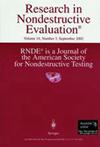钢桥基本金属的声学特性
IF 1
4区 材料科学
Q3 MATERIALS SCIENCE, CHARACTERIZATION & TESTING
引用次数: 0
摘要
超声检测(UT)通常用于桥梁制造过程中焊缝缺陷的定位和分类(或评估)。衰减和速度等声学特性的变化会对UT结果产生影响。焊缝中的缺陷可能会被遗漏,被错误地评定,或被错误地定位,并且可能会发生错误的呼叫,需要不必要的修理。本研究的目的是评估声学特性的变化对桥梁钢超声检测的影响。本文介绍了14种不同等级桥梁用钢板的声学性能测量结果。使用2.25 MHz和5 MHz换能器评估各种桥基材料的衰减。还使用正入射横波和电磁声(EMAT)换能器测定了这些钢的横波速度和声学各向异性比。利用实验结果和CIVA-UT仿真软件对AWS D1.5《桥梁焊接规范》提出修改建议,以限制焊接缺陷的幅度和位置测量误差。本文章由计算机程序翻译,如有差异,请以英文原文为准。
Acoustic Properties of Steel Bridge Base Metals
ABSTRACT Ultrasonic testing (UT) is typically conducted to locate and classify (or rate) defects in welds during bridge fabrication. Variations in acoustic properties such as attenuation and velocity can have an impact on the UT results. Defects in welds may be missed, incorrectly rated, or incorrectly located, and false calls may occur that require unnecessary repairs. The objective of the research was to assess the impact of variations in acoustic properties on the ultrasonic testing of bridge steel. This paper describes the results of acoustic property measurements of 14 different material heats representing various grades of steel plate used in bridges. The attenuation of various bridge base materials was evaluated using 2.25 MHz and 5 MHz transducers. Shear wave velocities and acoustic anisotropy ratios were also determined for some of these steels using normal incidence shear wave and electromagnetic acoustic (EMAT) transducers. The experimental results as well as CIVA-UT simulation software were used to develop recommended changes to the AWS D1.5 Bridge Welding Code in order to limit the amplitude and location measurement errors for weld flaws.
求助全文
通过发布文献求助,成功后即可免费获取论文全文。
去求助
来源期刊

Research in Nondestructive Evaluation
工程技术-材料科学:表征与测试
CiteScore
2.30
自引率
0.00%
发文量
14
审稿时长
>12 weeks
期刊介绍:
Research in Nondestructive Evaluation® is the archival research journal of the American Society for Nondestructive Testing, Inc. RNDE® contains the results of original research in all areas of nondestructive evaluation (NDE). The journal covers experimental and theoretical investigations dealing with the scientific and engineering bases of NDE, its measurement and methodology, and a wide range of applications to materials and structures that relate to the entire life cycle, from manufacture to use and retirement.
Illustrative topics include advances in the underlying science of acoustic, thermal, electrical, magnetic, optical and ionizing radiation techniques and their applications to NDE problems. These problems include the nondestructive characterization of a wide variety of material properties and their degradation in service, nonintrusive sensors for monitoring manufacturing and materials processes, new techniques and combinations of techniques for detecting and characterizing hidden discontinuities and distributed damage in materials, standardization concepts and quantitative approaches for advanced NDE techniques, and long-term continuous monitoring of structures and assemblies. Of particular interest is research which elucidates how to evaluate the effects of imperfect material condition, as quantified by nondestructive measurement, on the functional performance.
 求助内容:
求助内容: 应助结果提醒方式:
应助结果提醒方式:


